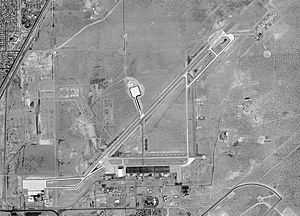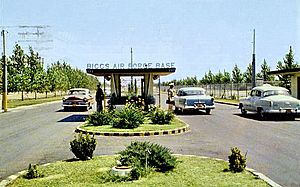Biggs Army Airfield facts for kids
Quick facts for kids
Biggs Army Airfield
|
|||||||||||
|---|---|---|---|---|---|---|---|---|---|---|---|

USGS 1996 photo of Biggs Army Airfield
|
|||||||||||
| Summary | |||||||||||
| Airport type | Military | ||||||||||
| Owner | |||||||||||
| Location | Fort Bliss, El Paso, Texas | ||||||||||
| Built | 1916 | ||||||||||
| In use | 1916–present | ||||||||||
| Elevation AMSL | 3,946 ft / 1,203 m | ||||||||||
| Coordinates | 31°50′56″N 106°22′01″W / 31.849°N 106.367°W | ||||||||||
| Runway | |||||||||||
|
|||||||||||
Biggs Army Airfield (IATA: BIF, ICAO: KBIF, FAA LID: BIF) is a military airbase for the United States Army. It is located on the Fort Bliss military base in El Paso, Texas. This airfield has a long history, starting over 100 years ago. It has been important for training pilots and supporting military operations.
Contents
History of Biggs Army Airfield
How Biggs Airfield Began
Biggs Army Airfield started in 1915 as a camp at Fort Bliss, Texas. In 1916, planes from the 1st Aero Squadron used it as a stop. These planes, called "Jennys," helped with scouting and delivering messages. This was during a time when the US Army was responding to raids by Pancho Villa.
By 1919, stronger planes called "DeHavilland DH.4s" (nicknamed "Flying Coffins") took over. They helped patrol the border between the US and Mexico. In 1920, a place called Camp Owen Bierne opened nearby for airship operations.
On January 25, 1925, the airfield was officially named "Biggs Field." It was named after Lieutenant James Berthes "Buster" Biggs. He was an officer from El Paso who died in a plane crash during World War I. In 1926, the original Biggs Field closed, and Camp Owen Beirne became the new Biggs Field.
Between World War I and World War II, Biggs Field was mainly a refueling stop for planes. When the US entered World War II, Fort Bliss was home to a large horse cavalry. But as the war changed, the need for horse cavalry disappeared.
Biggs Airfield During World War II
From 1942 to 1945, Biggs Army Airfield grew a lot. It was moved to its current spot. Huge hangars and longer runways were built for large bombers. Biggs became a key training center for planes like the Boeing B-17 Flying Fortress and B-24 Liberator.
Many bomber groups trained here. For example, the 303d Bombardment Group trained with B-17Fs in 1942. They learned high-altitude flying, navigation, and simulated combat missions. After training, they went to Europe and became a highly decorated unit.
Later, Biggs focused on training individual replacement pilots and crews. This meant that instead of training whole groups, they trained people in specific skills. These trained individuals would then join existing crews in combat zones.
In 1943, Biggs also became a training base for the new Boeing B-29 Superfortress bombers. These "very heavy" bombers were important for missions in the Pacific.
Biggs Airfield After World War II
After World War II, Biggs continued to be an important base. In 1947, Biggs Army Airfield became Biggs Air Force Base when the United States Air Force was created. In 1948, the base came under the control of the Strategic Air Command (SAC). SAC was in charge of America's long-range bombers and nuclear weapons.
Strategic Air Command Era
The 97th Bombardment Wing arrived at Biggs in 1948. They flew Boeing B-29 Superfortress bombers. This wing took part in many training exercises and deployments. They even deployed to the United Kingdom as part of SAC's efforts during the early Cold War.
In 1950, the 97th Bomb Wing started getting B-50 Superfortress planes. These were improved B-29s that could carry atomic weapons. Later, in 1954, they received B-47E Stratojet bombers. These were fast, swept-wing jet bombers designed to fly into Soviet airspace.
By 1958, the B-47s started to be replaced by the even newer Boeing B-52 Stratofortress. The B-52 became a key part of America's nuclear defense. In 1959, the 97th Bombardment Wing moved to another base.
Another important unit, the 95th Bombardment Wing, arrived at Biggs in 1952. They flew the huge Convair B-36 Peacemaker bomber. The B-36 was the largest piston-engine aircraft ever made. It was the main plane for delivering nuclear weapons until the B-52s arrived.
The 95th Bomb Wing also played a role in SAC's global missions. They deployed to places like Guam. By 1959, the B-36s were retired, and the 95th Bomb Wing started flying B-52B Stratofortresses. These B-52s flew long-range missions and performed airborne alert patrols. This was part of the strategy to deter the Soviet Union during the Cold War.
By 1966, newer missiles reduced the need for so many strategic bombers. Biggs Air Force Base was planned to close. However, the United States Army saw a need for the base to support Fort Bliss. So, on July 1, 1966, the base was transferred to the Army.
Biggs Army Airfield Today
In 1973, Biggs was officially reactivated as a permanent US Army Airfield. It became one of the largest active Army Airfields in the world.
In the late 1960s, the Defense Language Institute Support Command opened at Biggs Field. Here, Vietnamese civilians taught Army personnel to read, write, and speak Vietnamese. This training helped soldiers who would work with Vietnamese people during the Vietnam War.
Biggs Army Airfield played a big role in 1990–91. It supported the huge airlift of troops and equipment for Operations Desert Shield and Desert Storm. Today, Biggs Airfield still hosts large transport planes like the Lockheed C-5 Galaxy. These planes move soldiers and equipment around the world.
Biggs Field is also known for hosting the annual "Amigo Airshow" in October. Many people come to see the attractions and military equipment. The United States Navy Blue Angels often perform amazing aerobatic maneuvers at the show.
NASA Use
Biggs Airfield was also used by NASA. It served as a stopover point for the Shuttle Carrier Aircraft. This special plane transported the Space Shuttle from Edwards Air Force Base in California to the Kennedy Space Center in Florida.
Aircraft Assigned (Strategic Air Command)
Here are some of the famous aircraft that were based at Biggs when it was a Strategic Air Command base:
- Boeing B-29 Superfortress (bomber)
- Boeing B-50 Superfortress (bomber)
- Convair B-36 Peacemaker (bomber; had both piston and jet engines)
- Boeing B-47 Stratojet (bomber)
- Boeing B-52 Stratofortress (bomber)
Units at Biggs Army Airfield
Biggs Army Airfield is home to important units that help the Army.
 1st Armored Division
1st Armored Division
- Combat Aviation Brigade, 1st Armored Division "Iron Eagle"
- Headquarters and Headquarters Company (HHC)
- 1st Battalion (Attack), 501st Aviation Regiment "Iron Dragons"
- 2nd Battalion (General Support), 501st Aviation Regiment "Desert Knights"
- 3rd Battalion (Assault), 501st Aviation Regiment "Apocalypse"
 3rd Squadron (Heavy Attack-Reconnaissance), 6th Cavalry Regiment "Heavy Cavalry"
3rd Squadron (Heavy Attack-Reconnaissance), 6th Cavalry Regiment "Heavy Cavalry" 127th Aviation Support Battalion "Work Horse"
127th Aviation Support Battalion "Work Horse"
- Combat Aviation Brigade, 1st Armored Division "Iron Eagle"


